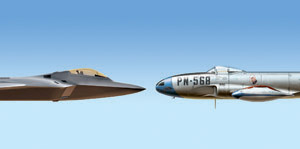In 2004 mock combat exercises, Indian Air Force pilots flying Russian-made Su-30s unexpectedly waxed USAF pilots flying front-line F-15Cs. This rumble on the subcontinent was a matchup of two “fourth generation” warplanes. The outcome jolted the Americans; it revealed they no longer had technological superiority.
One year later, USAF’s “fifth generation” F-22 Raptor—an agile, stealthy, radically new aircraft—entered operational service. We mean no disrespect by saying that, should the Indians today send their Su-30s against it, their excellent fighter pilots wouldn’t stand a chance.
 |
The F-22 and F-80 represent Gen 5 and Gen 1. |
Air dominance is like a cut flower—it can fade quickly. The Cope India exercises taught many lessons—about the importance of good training and tactics, about the need to avoid underestimating your adversary. Here’s another: If you are fighting outnumbered, you’d better have the superior aircraft.
Because of the enormous stakes, it is important to understand the practical significance of the difference in fighter generations.
The exact list of capabilities and aircraft belonging to each generation is debatable; the classification refers only to jet-powered fighters. Use of the generations helps to demarcate technological advances and capabilities that emerge worldwide at around the same time.
• Gen 1. This category comprised the earliest jet fighters. Classic cases were Germany’s Me 262 and Britain’s Meteor, both of which entered service in 1944 toward the end of World War II, and the US F-80, which came along the next year. The hallmark of the Gen 1 fighter was its revolutionary advance in speed over its piston-engine predecessors.
• Gen 2. Second generation fighters starred in the Korean War. Most notable were the USAF F-86 and the Soviet MiG-15. According to Walter J. Boyne, writing in Lockheed Martin’s Code One magazine, this generation “sought to maximize fighter performance by tailoring the airframe to the potential of the jet engine.” Example: the use of highly swept wings.
• Gen 3. State of the art in the late 1950s and early 1960s, fighters of the third generation included USAF’s “Century Series” fighters—F-100, F-101, F-102, F-104, F-105, F-106—and the Soviet MiG-17 and MiG-21. They featured advanced missiles, supersonic speed, and more-sophisticated engines. The F-4 Phantom was a late Gen 3 fighter, and perhaps iconic of the group.
• Gen 4. These fighters debuted in the mid-1970s and are still tops in most of the world. This group includes USAF’s F-15 and F-16 and Russia’s Su-27 and MiG-29 (and offshoots). Weapons, engines, and avionics put earlier aircraft to shame. Thirty years of improvements have pushed some fighters into a group known as “Generation 4.5.” These include the latest F-15s and F-16s for overseas customers, and the MiG-35, Su-30, and Eurofighter Typhoon.
• Gen 5. The class is defined by all-aspect stealth, internal carriage of precision weapons, active electronically scanned array (AESA) radars, and “plug and play” electronics. There is only one member—the F-22. The F-35 Lightning II will join the club when it goes operational in a few years. No Russian Gen 5 fighter is at hand, it is thought.
What about a Gen 6? This class is on the drawing board, but won’t be available for decades. It could feature hypersonic speed, dual-mode engines, and adaptive shapes.
Some still issue calls for the Pentagon to continue buying legacy Gen 4 aircraft. Sen. Christopher S. Bond (R-Mo.) has called the F-15 Eagle a “very viable alternative to the F-22.” The F-15 is assembled by Boeing in Bond’s home state.
Just last year, the Congressional Budget Office presented several “budget options” for Congress. One was to cancel the F-35 and buy more F-16s and F/A-18s instead. CBO wrote that “new F-16 and F/A-18 aircraft—with upgraded radar systems, precision weapons, and digital communications—will be sufficiently advanced to meet the threats the nation is likely to face in the foreseeable future.”
That is, in a word, bogus. Later generation aircraft are far superior to previous generation fighters. The early returns from F-22 visits at Red Flag and Northern Edge exercises bear this out. The Raptors easily cleared the skies of Gen 4 fighters. Congress has gone so far as to ban foreign F-22 sales, even to longtime allies.
Allies will be able to buy the F-35. Until the F-35 taxis out onto some foreign runway, though, the US has a unique advantage—no other nation has a fifth generation aircraft.
In the 1980s and 1990s, the F-15 was the world’s dominant fighter, with unprecedented success in aerial combat. The years of advantage for Gen 4 fighters have passed, however. The Gen 4.5 machines are making it difficult for them.
The Air Force desperately needs to replace its oldest F-15s and F-16s with something better than what the opposition can buy. For the next few years, the F-22 is the only option.
More information: http://www.codeonemagazine.com/archives/2005/articles/oct_05/gap/index.html